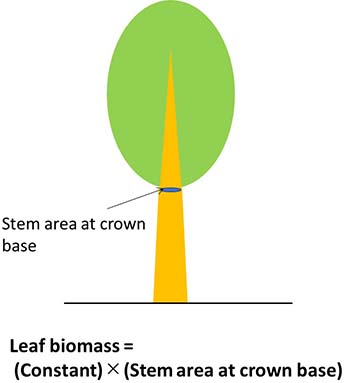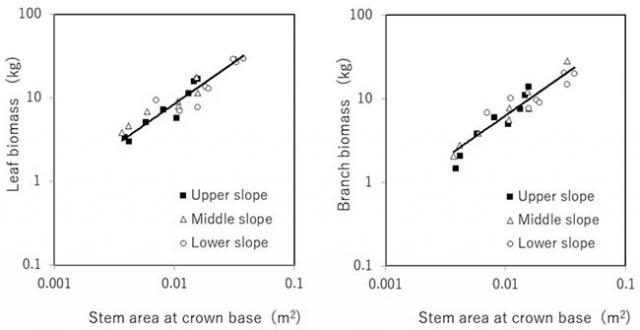Home > Research > Research Results > Research Results 2020 > A method estimating leaf biomass is applicable for forests at different slope positions
Update:September 4, 2020
Main content starts here.
A method estimating leaf biomass is applicable for forests at different slope positions
| Article title |
A simple method for leaf and branch biomass estimation in Japanese cedar plantations |
|---|---|
| Author (affiliation) |
Yoshiyuki Inagaki (a), Asami Nakanishi (b), Takeshi Tange (c) (a) Shikoku Research Center, FFPRI, Kochi, Japan. (b) Kyoto University, Kita-ku, Kyoto, Japan. (c) The University of Tokyo, Bunkyo-ku, Tokyo, Japan. |
| Publication Journal |
Trees: Structure and Function 34: 349–356, April. 2020 DOI:10.1007/s00468-019-01920-8( External link ) |
| Content introduction |
In order to understand such things as carbon fixation functions and biomass cycles of Japanese cedar plantations, it is very important to estimate the leaf biomass. So far, allometric equations2) based on the pipe model theory on tree form1) which have been derived from felling surveys have been used to estimate the leaf and branch biomass of cedar forest stands (Fig.1). However, it has not been clear whether or not the same allometric equation can be used for cedar trees that have grown in different topographies, such as the upper and lower parts of slopes. Therefore, the present study made a comparative examination of allometric equations that had been derived at 4 sites for cedar plantations where upper and lower slopes had different topographies. As a result, it was found that in middle-age forests of up to 60 years in age, the same allometric equation could be used to estimate the leaf and branch biomass from the stem area at crown base, even when the topographies were different, so that allometric equation could be used for both the upper and lower parts of a slope (Fig. 2). However, the allometric equation differed depending on the site, so we could see that a site-specific allometric equation had to be derived for each local area. Therefore, it was possible to use a universal allometric equation within a certain site to make simple estimates of leaf and branch biomass. This finding will be able to provide fundamental information for making multi-faceted evaluations of the functions of local forests.
Notes 1) According to a paper on tree form and leaf biomass presented in 1964 by Dr. Kichiro Shinozaki et al, there is a proportional relationship between leaf biomass and stem area at crown base. 2) This is a relational expression established between two indices (tree height, and diameter at breast height, etc).
Figure 1:Leaf biomass estimated based on the pipe model theory. The leaf biomass can be estimated by multiplying the unit stem area (area of the stem at crown base) by a constant.
Figure 2:Allometric equation for leaf biomass, branch biomass, and stem area at crown base (example from the Chichibu area). This is a universal equation that can be used to estimate the leaf and branch biomass within that area, regardless of the topography. |
Copyright © Forest Research and Management Organization. All rights reserved.


